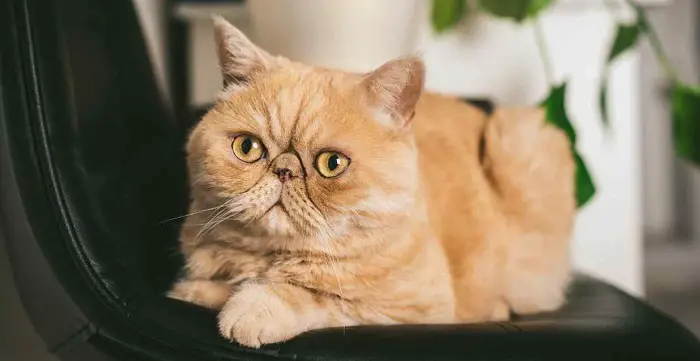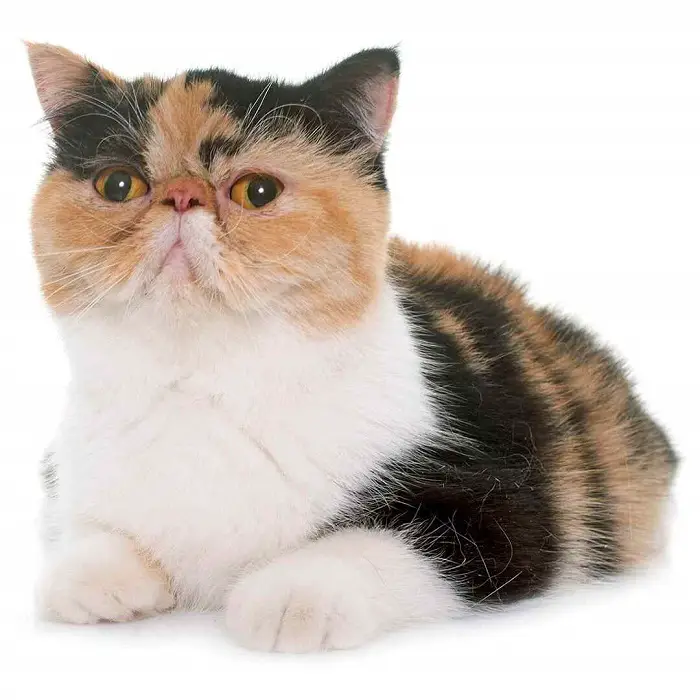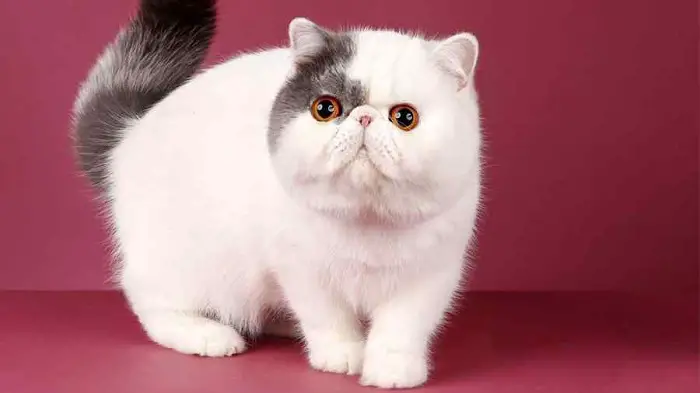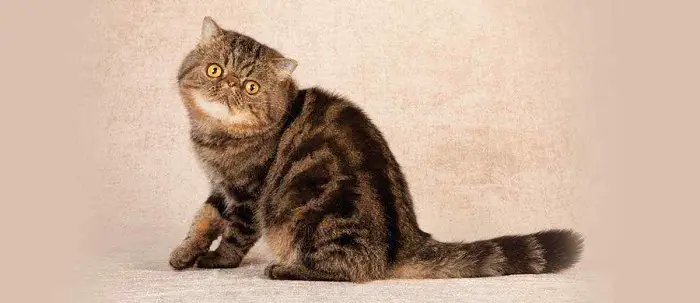The Exotic Shorthair is a cat breed known for its adorable and unique appearance. It is often described as the “shorthaired Persian” because it shares many physical characteristics with the Persian cat breed. The Exotic Shorthair cat was developed by crossing Persians with American Shorthairs to achieve a similar look to the Persians but with shorter hair.
Exotic Shorthairs have a round faces with large, round eyes, a flat nose, and a sweet expression. They have a sturdy and compact body with a thick, plush coat that is dense and soft. The coat comes in various colors and patterns, including solid colors, tabby, tortoiseshell, and bi-color.
Origin and History of Exotic Shorthair Cat
The Exotic Shorthair cat breed has a fascinating history closely intertwined with the Persian cat breed. The breed was developed in the 1950s and 1960s in the United States as breeders sought to create a Persian-like cat with a shorter, more manageable coat.
To achieve this goal, Persian cats were crossed with American Shorthair cats. The intention was to retain the Persian’s distinctive appearance, including its round face, large eyes, and sweet expression while introducing the short coat gene from the American Shorthair breed. Through selective breeding, breeders created a breed with the desired physical characteristics of a Persian but with a shorter, plush coat.
The initial crosses produced longhaired kittens, but breeders continued to breed those with shorter coats selectively. Over time, the offspring consistently exhibited the desired short coat, and cat registries officially recognized the breed as the Exotic Shorthair in the 1960s.
The Exotic Shorthair quickly gained popularity among cat enthusiasts and became recognized for its unique appearance and easy-to-maintain coat. It was recognized by significant cat associations, such as The International Cat Association (TICA) and the Cat Fanciers’ Association (CFA), which further helped solidify its status as a distinct breed.
Since its creation, the breed has continued to be refined and bred for its specific traits. Breeders have focused on maintaining the Exotic Shorthair’s Persian-like features, such as its round face and large eyes while ensuring the breed’s health and temperament.
Today, the Exotic Shorthair is a well-established and beloved breed. It is recognized by various cat registries worldwide and is cherished for its cute and cuddly appearance, gentle nature, and low-maintenance coat.
Physical Features of Exotic Shorthair
The Exotic Shorthair cat breed shares many physical features with the Persian breed but with a shorter, more manageable coat. Here are some of the prominent physical characteristics of the Exotic Shorthair:
- Head: The Exotic Shorthair has a round head with a broad skull. The face is full-cheeked and gives the cat a sweet and open expression.
- Eyes: They have large, round eyes that are usually wide-set. Eye color of the cat can vary depending on the coat color, but shades of copper and gold are standard.
- Nose: The nose is short and broad, giving the breed its distinctive “pushed-in” or “flat-faced” appearance. The nose is set low between the eyes.
- Ears: The Exotic Shorthair has small to medium-sized ears set wide apart on the head. The ears are rounded at the tips and covered with fur.
- Body: The body of the Exotic Shorthair is sturdy and compact, with a medium to large size. The breed has a broad chest and a level back. They have a well-rounded abdomen.
- Legs and Paws: The legs are short and robust, with round and firm paws. The toes are tufted with fur, adding to the overall appearance.
- Tail: The cat’s tail is medium length and well-proportioned to the body. It is thick at the base and tapers to a rounded tip.
- Coat: The Exotic Shorthair has a dense, plush coat that is soft and luxurious. The fur is shorter than a Persian’s but still provides a “teddy bear” look. The coat comes in various colors and patterns, including solid colors, tabby, tortoiseshell, and bi-color.
- Overall Appearance: The Exotic Shorthair has a round, cobby (stocky) appearance. Its physical features combine to create a cute, cuddly, and doll-like appearance.
It’s important to note that due to selective breeding, there may be some variation in physical features within the breed, such as variations in the size and shape of the head or eye color. However, these general characteristics are typically seen in the Exotic Shorthair breed.
The Appearance of Exotic Shorthair Cat
The appearance of the Exotic Shorthair cat can be described as adorable, cuddly, and reminiscent of a teddy bear. Here are some more details about the appearance of the Exotic Shorthair:
- Face: The Exotic Shorthair has a round face with full cheeks. The facial structure resembles a Persian cat, with a broad skull and a flat or “pushed-in” nose. The face is one of the breed’s most distinctive features, giving it a cute and appealing expression.
- Eyes: The Exotic Shorthair has large, round eyes that are expressive and captivating. The eye color of the Exotic Shorthairs can vary depending on the coat color, but copper, gold, and green shades are standard. The eyes are set wide apart, contributing to the breed’s sweet and innocent look.
- Ears: The ears of the Exotic Shorthair are relatively small to medium in size and set wide apart on the head. The tips of the ears are rounded and covered with fur. The ears contribute to the overall balance and harmony of the cat’s face.
- Body: The body of the Exotic Shorthair is compact, muscular, and well-rounded. It has a broad chest and a sturdy frame. While the breed is not as large or heavy as some other breeds, it has a substantial feel.
- Legs and Paws: The Exotic Shorthair has short and robust legs proportionately to the body. The paws are round and firm, often adorned with tufts of fur between the toes.
- Coat: The most notable feature of the Exotic Shorthair’s coat is its dense and plush texture. The fur is shorter than a Persian’s, but it feels soft and luxurious. The coat can come in various colors and patterns, including solid colors, tabby, tortoiseshell, and bi-color. The coat’s density gives the cat a full and fluffy appearance.
- Tail: The tail of the Exotic Shorthair is of medium length and is in proportion to the body. It is thick at the base and tapers to a rounded tip. The tail is covered in the same plush fur as the body.
Overall, the Exotic Shorthair’s appearance is charming and endearing, with its round face, large eyes, and plush coat. Its cute and cuddly look often captures the hearts of cat lovers.
Colors of Exotic Shorthairs
The Exotic Shorthair cat breed comes in various colors and patterns. Here are some of the standard colors and patterns you can find in Exotic Shorthairs:
- Solid Colors: Exotic Shorthairs can come in various solid colors, including black, white, blue, cream, red, chocolate, lilac, and their corresponding dilute variations. These cats have a uniform color throughout their coat.
- Tabby Patterns: Tabby patterns are common in Exotic Shorthairs. They can have classic tabby, mackerel tabby, or spotted tabby patterns in brown, blue, silver, and cream colors. These patterns feature stripes, swirls, or spots on the coat.
- Tortoiseshell: Tortoiseshell Exotic Shorthairs have a mix of black, red, or cream patches on their coat. The distribution of colors can vary, resulting in unique and intricate patterns.
- Bicolor: Bicolor Exotic Shorthairs combine two colors, typically with a white base and patches of another color. The other colors can be black, blue, red, cream, or other solid colors.
- Calico: Calico Exotic Shorthairs, also known as tricolor, have patches of white, black, and orange/red on their coat. The colors are usually well-distributed and can create a beautiful mosaic effect.
- Colorpoint: Some Exotic Shorthairs exhibit colorpoint patterns similar to those seen in Siamese cats. These cats have a lighter body color with darker points on their ears, face, paws, and tail. Common colorpoint variations include seal, blue, chocolate, and lilac points.
- Silver and Golden: Exotic Shorthairs can also have silver or golden coloring. These cats have a shimmering silver or golden undercoat, which gives them a luxurious and striking appearance.
Behavior and Temperament of Exotic Shorthair Cat
The Exotic Shorthair cat breed is known for its calm, gentle, and affectionate temperament. Here are some common behavioral traits and characteristics of Exotic Shorthairs:
- Affectionate: Exotic Shorthairs are typically very loving and enjoy being close to their human companions. They often seek out cuddles and will happily curl up in your lap or nestle beside you.
- Gentle and Easygoing: These cats have a laid-back and easygoing nature. They are generally not overly demanding or hyperactive, preferring a more relaxed and serene lifestyle. They are well-mannered and adaptable, making them suitable for various living environments.
- Playful: While Exotic Shorthairs may not be as high-energy as some other breeds, they still have a playful side. They enjoy interactive play sessions and can be entertained by toys that stimulate their hunting instincts.
- Sociable: Exotic Shorthairs are typically sociable and enjoy the company of their human family members. They are known for being good with children and can get along well with other pets, including cats and dogs, with proper introductions.
- Quiet: Exotic Shorthairs are generally not very vocal cats. They are not prone to excessive meowing or loud vocalizations. However, they may communicate their needs through softer sounds or by purring.
- Easy to Handle: Due to their easygoing nature, Exotic Shorthairs are usually easy to handle and are known to tolerate being picked up and carried. They are generally well-behaved during grooming sessions, which is a plus considering their plush coats require some maintenance.
- Relaxed Demeanor: Exotic Shorthairs tend to have a relaxed and calm demeanor. They are not known to be overly skittish or anxious and can adapt well to different household routines and environments.
Care and Management of Exotic Shorthairs
Caring for an Exotic Shorthair cat involves health, grooming, feeding, and overall well-being. Here are some critical care and management considerations for Exotic Shorthairs:
- Regular Veterinary Care: Schedule regular visits to a veterinarian for comprehensive check-ups, vaccinations, and preventive care. Regular veterinary care helps ensure your cat’s overall health and can catch any potential issues early on.
- Balanced Diet: Provide a nutritionally balanced diet that meets the specific needs of your exotic shorthair. Based on your cat’s age, weight, and dietary needs, please consult your veterinarian to determine the right kind and quantity of food for them.
- Hydration: Ensure your cat always has access to fresh and clean water. Encourage regular drinking by providing multiple water sources throughout your home.
- Grooming: Exotic shorthairs have dense and plush coat that requires regular grooming to keep them healthy and free from mats. Brush your cat’s coat a few times weekly to remove loose hair and prevent tangles. Exotic Shorthairs may also benefit from occasional bathing to keep their coat clean.
- Eye Care: Exotic Shorthairs may be prone to eye discharge and tear stains due to their facial structure. Gently wipe their eyes with a damp cloth or use a veterinarian-approved eye cleaner to keep the area clean and prevent discomfort.
- Nail Trimming: Regularly trim your cat’s nails to keep them at a comfortable length. Use proper cat nail clippers or consult a veterinarian or professional groomer for assistance.
- Dental Care: Dental health is essential for Exotic Shorthairs. Establish a dental care routine that includes regular teeth brushing with a cat-specific toothpaste and toothbrush. Dental treats or toys designed to promote oral health can also be beneficial.
- Environmental Enrichment: Provide environmental enrichment to keep your Exotic Shorthair mentally stimulated and physically active. This can include interactive toys, scratching posts, climbing trees, and designated play areas.
- Litter Box Maintenance: Clean the litter box and provide your cat’s preferred type. The litter box should be scooped daily, and change the litter regularly to maintain cleanliness and ensure your cat’s comfort.
- Emotional Well-being: Exotic Shorthairs thrive on companionship and human interaction. Spend quality time with your cat, provide them with affection and attention, and engage in interactive play sessions to keep them mentally stimulated and happy.
The Health of Exotic Shorthair Cat
Like any other breed, the Exotic Shorthair cat can be prone to specific health conditions. While not all Exotic Shorthairs will experience these issues, they must be aware of potential health concerns. Here are some health conditions that are commonly associated with the Exotic Shorthair breed:
- Polycystic Kidney Disease (PKD): PKD is a genetic disorder that affects the kidneys. It can cause the development of cysts in the kidneys, leading to kidney dysfunction. Responsible breeders perform genetic testing to minimize the occurrence of PKD in Exotic Shorthairs.
- Brachycephalic Airway Syndrome: The Exotic Shorthair’s flat face can result in a shorter airway, which may lead to respiratory issues. These cats may be prone to breathing difficulties, snoring, and overheating, especially in hot or humid conditions.
- Dental Issues: Exotic Shorthairs can be susceptible to dental problems, including periodontal disease, tooth decay, and gingivitis. Regular dental care, including teeth brushing and professional cleanings, is crucial for oral health.
- Eye Conditions: Due to their facial structure, Exotic Shorthairs may be prone to eye-related issues such as excessive tearing, eye infections, and entropion (inward rolling of the eyelids). Regular eye cleaning and monitoring for any signs of discomfort or infection are essential.
- Obesity: Exotic Shorthairs tend to gain weight, so it’s essential to monitor their diet and provide regular exercise to prevent obesity-related health problems, such as diabetes and joint issues.
- Heat Sensitivity: Exotic Shorthairs may be more heat-sensitive due to their shortened airways. The cats can struggle to regulate their body temperature, making them more prone to heatstroke. Providing them a relaxed and comfortable environment is essential, especially during hot weather.
Regular veterinary check-ups, proper nutrition, and a healthy lifestyle can help manage and prevent potential health issues in Exotic Shorthairs. Working with responsible breeders who prioritize genetic testing and health screenings can also help reduce the risk of inherited health conditions. It’s always advisable to consult with a veterinarian for personalized guidance regarding the health and well-being of your Exotic Shorthair cat.
Concluding Remarks on Exotic Shorthair Cat
The Exotic Shorthair cat is a delightful and charming breed known for its adorable appearance and sweet temperament. With its round face, large expressive eyes, and plush coat, the Exotic Shorthair captures the hearts of many cat lovers. Their calm and gentle nature, combined with their affectionate personality, makes them excellent companions.
While Exotic Shorthairs share some potential health concerns with other breeds, responsible breeding practices, and proper care can help minimize the risk of these conditions. Regular veterinary check-ups, a balanced diet, grooming, and dental care, are essential to their overall well-being.
Exotic Shorthairs are generally pleasant and get along well with people of all ages and other pets. They thrive on companionship and enjoy spending time with their human family members. However, they also appreciate their personal space and can be content spending time alone.
Overall, the Exotic Shorthair cat is a loving and low-maintenance breed that brings joy and companionship to many households. With their adorable appearance, gentle nature, and easygoing personality, they make beautiful additions to families seeking a calm and affectionate feline companion.



